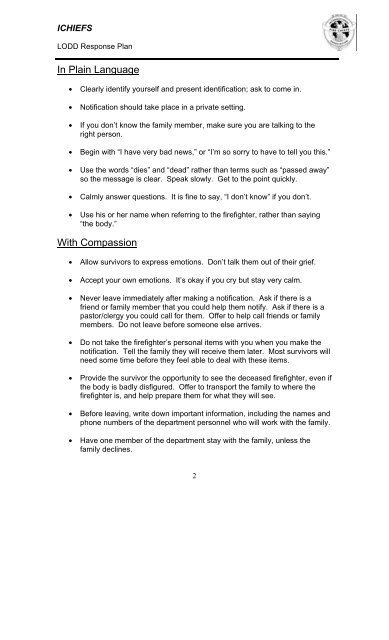Five Principles of Notification - IAFF
Five Principles of Notification - IAFF
Five Principles of Notification - IAFF
Create successful ePaper yourself
Turn your PDF publications into a flip-book with our unique Google optimized e-Paper software.
ICHIEFS<br />
LODD Response Plan<br />
In Plain Language<br />
• Clearly identify yourself and present identification; ask to come in.<br />
• <strong>Notification</strong> should take place in a private setting.<br />
• If you don’t know the family member, make sure you are talking to the<br />
right person.<br />
• Begin with “I have very bad news,” or “I’m so sorry to have to tell you this.”<br />
• Use the words “dies” and “dead” rather than terms such as “passed away”<br />
so the message is clear. Speak slowly. Get to the point quickly.<br />
• Calmly answer questions. It is fine to say, “I don’t know” if you don’t.<br />
• Use his or her name when referring to the firefighter, rather than saying<br />
“the body.”<br />
With Compassion<br />
• Allow survivors to express emotions. Don’t talk them out <strong>of</strong> their grief.<br />
• Accept your own emotions. It’s okay if you cry but stay very calm.<br />
• Never leave immediately after making a notification. Ask if there is a<br />
friend or family member that you could help them notify. Ask if there is a<br />
pastor/clergy you could call for them. Offer to help call friends or family<br />
members. Do not leave before someone else arrives.<br />
• Do not take the firefighter’s personal items with you when you make the<br />
notification. Tell the family they will receive them later. Most survivors will<br />
need some time before they feel able to deal with these items.<br />
• Provide the survivor the opportunity to see the deceased firefighter, even if<br />
the body is badly disfigured. Offer to transport the family to where the<br />
firefighter is, and help prepare them for what they will see.<br />
• Before leaving, write down important information, including the names and<br />
phone numbers <strong>of</strong> the department personnel who will work with the family.<br />
• Have one member <strong>of</strong> the department stay with the family, unless the<br />
family declines.<br />
2
















